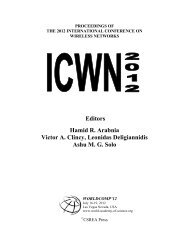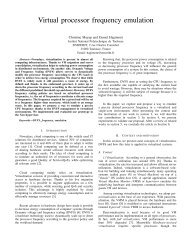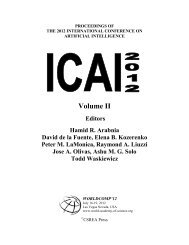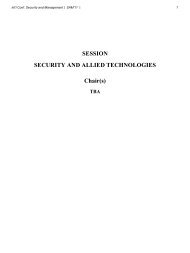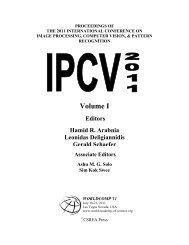SESSION NOVEL ALGORIHMS AND APPLICATIONS + ...
SESSION NOVEL ALGORIHMS AND APPLICATIONS + ...
SESSION NOVEL ALGORIHMS AND APPLICATIONS + ...
Create successful ePaper yourself
Turn your PDF publications into a flip-book with our unique Google optimized e-Paper software.
16 Int'l Conf. Foundations of Computer Science | FCS'11 |<br />
Performance and Quality of Random Number Generators<br />
V. du Preez, M.G.B. Johnson, A. Leist and K.A. Hawick<br />
1 Computer Science, Massey University<br />
2 Albany, North Shore 102-904, Auckland, New Zealand<br />
Abstract— Random number generation continues to be<br />
a critical component in much of computational science<br />
and the tradeoff between quality and computational performance<br />
is a key issue for many numerical simulations.<br />
We review the performance and statistical quality<br />
of some well known algorithms for generating pseudo<br />
random numbers. Graphical Processing Units (GPUs)<br />
are a powerful platform for accelerating computational<br />
performance of simulations and random numbers can<br />
be generated directly within GPU code or from hosting<br />
CPU code. We consider an alternative approach using<br />
high quality and genuinely “random” deviates generated<br />
using a Quantum device and we report on how such a<br />
PCI bus device can be linked to a CPU program. We<br />
discuss computational performance and statistical quality<br />
tradeoffs of this architectural model for Monte Carlo<br />
simulations such as the Ising system.<br />
Keywords: quantum random number generation; GPU;<br />
CUDA.<br />
1. Introduction<br />
The fast generation of good quality random numbers<br />
[1]–[6] is a long-standing challenge [7], [8]. Random<br />
numbers are needed for many applications, but are used<br />
in very large quantities in computer simulations that<br />
employ the Monte-Carlo algorithm [9], [10]. It is neither<br />
trivial nor computationally cheap to generate large sets<br />
of pseudo-random numbers that have the right statistical<br />
”randomness” needed to perform an unbiased calculation.<br />
Until recently it has not been practical to use random<br />
number generation hardware that was economically priced<br />
and suitably unbiased. Instead, pseudo random numbers<br />
that were generated from a suitable deterministic algorithm<br />
were employed. A great deal has been written in<br />
the literature about such algorithms, but for the most part<br />
there are many very good ones that are “random enough”<br />
and are at least uncorrelated with the application so that<br />
they suffice. One important area of use has been the<br />
numerical investigation of phase transitions and critical<br />
phenomena. In such work the Monte Carlo algorithm is<br />
used to sample appropriate points in a physical model<br />
space to simulate the actual dynamical behaviour of a<br />
model and identify the location of critical points – abrupt<br />
changes - that result when a model parameter such as<br />
temperature changes by a small amount.<br />
This work is very demanding and a certain degree<br />
of caution is perceived in the reported literature as researchers<br />
go to great lengths to be sure their simulations<br />
Fig. 1: Quantis RNG Card for PCI Bus, showing four<br />
independent quantum generator devices.<br />
are not overly biased by random numbers with unfortunate<br />
statistical properties.<br />
Pseudo-random number generators are often formulated<br />
in terms of mathematical recurrence relations [11]<br />
whereby repeated application of a transformation will<br />
project a number to another in an apparently random<br />
or decorrelated sequence - at least to the extend that<br />
any patterns discernible in the resulting sequence are on<br />
a scale that is irrelevant to the application using them.<br />
Any random or pseudo random number generator delivers<br />
a sequence of random deviates - either floating point<br />
uniform deviates or integers or sometimes just plain bits.<br />
An application will use or consume deviates from such a<br />
sequence as it runs.<br />
There are still some philosophically deep questions<br />
concerning what it really means for a sequence of deviates<br />
to be truly random. It is widely believed however that<br />
some quantum physical processes yield deviates that are<br />
as random as we can ever make them. Such devices are<br />
presently available as special purpose cards or external<br />
drivers that connect via a bus-based hardware interface<br />
such as PCIe or USB. We investigate the use of the ID<br />
Quantique “Quantis” device below in section 4. Intel and<br />
other CPU manufacturers [12] are now actively considering<br />
provision of random number generation hardware<br />
directly on the chip. This closeness to the arithmetic and<br />
logic hardware means that these devices will produce<br />
very fast deviates, and the expectation is that the thermal<br />
noise and quantum processes involved are sufficiently<br />
well understood at a statistical level to ensure that these<br />
sources are also unbiased.<br />
Our paper is structured as follows: In Section 2 we<br />
review some key issues for random number generation. In<br />
Section 3 we briefly review the Ising model and associated<br />
Monte Carlo analysis algorithms as demanding consumers



